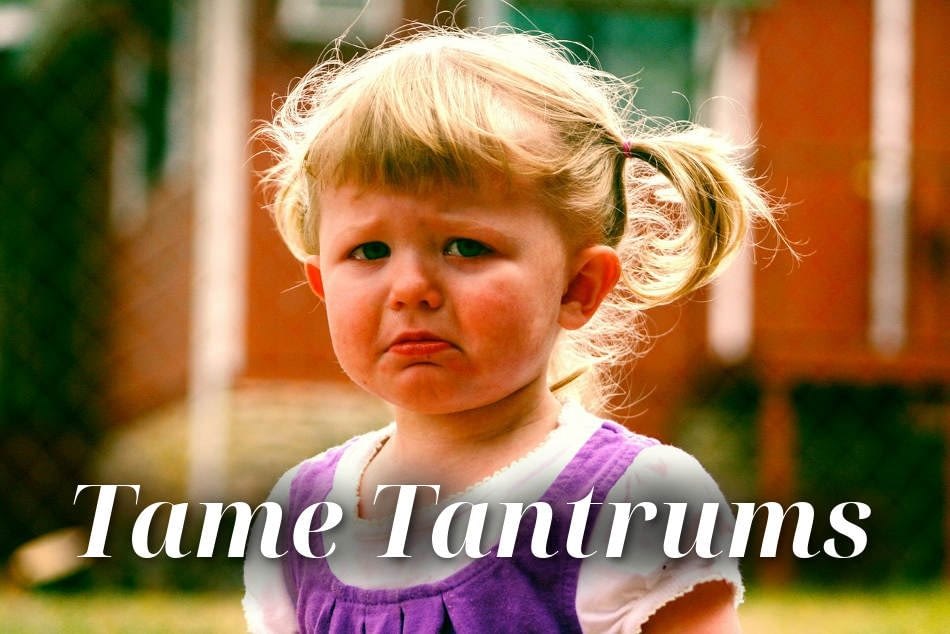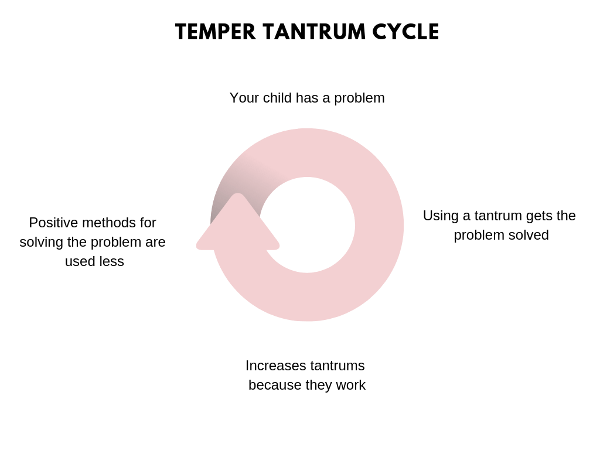The Ultimate Guide to Taming Your 3 Year Old’s Tantrums

“18% of 3 year olds have at least one temper tantrum per day”
Grover (2008)
She lay on the floor in the middle of the aisle. Facedown, kicking and screaming.
People were starting to look now. She hadn’t fallen, she had thrown herself violently to the ground.
Through the screaming and tears, I could still hear her shouting “Give it to me!”.
How did this happen? Well, one minute before. We were stood in the kitchen aisle at the store. I was looking for a new kitchen knife, concentrating on what might be the best value when she had asked me if she could look at one.
That’s when I had said that word. “No” … “It’s dangerous, they aren’t for children sweetie”. I wasn’t prepared for what came next. It felt like the whole store was watching. Just because I wouldn’t let her play with the carving knives.
ARTICLE QUICK LINKS
If you are searching for an answer to a specific question, use the links below to jump straight to it.
- WHY DOES MY 3 YEAR OLD HAVE TANTRUMS?
- COULD MY CHILD HAVE LEARNED THIS BEHAVIOR FROM ME?
- TANTRUM VS A MELTDOWN
- HOW TO TAME YOUR 3 YEAR OLD’S TANTRUMS – A SIMPLE 3 STEP PROCESS
- HOW YOU CAN PREVENT TANTRUMS IN THE FUTURE?
- WHEN SHOULD YOU WORRY ABOUT TANTRUMS? – RED FLAGS
- WARNING SIGNS OF ABNORMAL TEMPER TANTRUMS
- WHAT YOU SHOULD DO IF YOUR 3 YEAR OLD IS HITTING?
HOW TO TAME YOUR 3 YEAR OLD’S TANTRUMS – A SIMPLE 3 STEP PROCESS
I have put together a complete step by step guide on how to tackle your 3 year old’s temper tantrums. I am confident that if you use all the information in this guide it will help tame their outbursts or sometimes avoid them altogether. It has been successful for me, so I hope it will be the same for you.

STEP 1: PREPARATION
1. PLANNING IS KEY: Make sure you have a plan. Don’t leave it to the last minute to decide what to do when your 3-year-old flips out and starts screaming in public. Panic sets in and you are more likely to make poor decisions.
Planning ahead involves things like having snacks or a drink ready to try if you think they might be starting on the road to a tantrum.
Have you decided how long to wait until you feel like you need to remove them from a situation for a timeout? What triggers can you avoid that may set them off? It is vital to make these decisions ahead of time.
Planning ahead also means you keep your response to a tantrum consistent. Doing the same thing every time your little one starts to act up reinforces the idea that you have control over the situation. They will feel reassured knowing how you will respond and promotes good behavior.
2. KEEP CALM: I know it is easier said than done. I have been in that situation so many times. I have lost my temper, been cross, maybe even let out a few curse words. Then I have felt terrible afterward. Why did I let my emotions get to me? I guess that is what we are all learning to do, even your little one to control our emotions.
Keep as calm as possible. It is likely that their tantrum is feeding on your attention. Getting angry yourself will only make the situation worse. Remember, you are the adult, you are in control of the situation.
If you have already lost your temper. It is not too late. Apologize to them, take a deep breath and a few seconds away (if it is safe to do so). Then restart as you meant to in the first place. It takes practice, you will become cool as a cucumber in no time!
3. TANTRUMS ARE DIFFICULT TO STOP: Once a tantrum has started, they are very difficult to stop. If you try and talk to your 3-year-old and negotiate with them to calm them down. This only feeds into the tantrum. By talking to them when they are having a tantrum, you are giving them the attention they need to carry it on.
It is better to deal with this tantrum and try and avoid the triggers for the next one rather than desperately trying to stop it.
4. TRY AND STICK TO YOUR ROUTINE: Routines work. Kids feel comfortable when they know what is coming next. It gives children a structure that helps them avoid getting frustrated or confused.
I know it may sometimes be difficult to stick to a routine. Just make sure you have a general daily routine and try your best, it doesn’t have to be perfect. With a routine, your 3-year-old will feel happier and less frustrated.
STEP 2: DEALING WITH THE TANTRUM
5.USE DISTRACTIONS: This is your first line of defense against the dreaded tantrum. If you feel like they are starting to get frustrated by a situation, try and distract them. A quick change of focus onto something else might just change their mood.
Children’s moods can change lightning fast. So take advantage of that.
You know your child well. Think of things that they love the most for good distractions. Keep them handy (That’s where planning comes in). Is it a favorite toy? Is it a special blanket? Do they like trucks? Or birds?
The downside is that distraction doesn’t always work. But it’s worth a try. I know it has worked for me plenty of times. Sometimes by simply shouting Oooh look, there’s a bird!
6. TIRED OR HANGRY?: Many tantrums are caused by your child being tired or hungry. Two things that are easy to fix. Make sure you plan ahead. Bring some snacks and water for them. Try and stick to your daily routine so you know that they won’t become overtired.
7. IGNORE THE TANTRUM: Most of the time, a temper tantrum is your child trying to grab your attention. So the best way to deal with a tantrum is to ignore it as much as possible. Make sure your child is safe, but don’t talk or negotiate with them until they have calmed down.
Just be there for them when the tantrum starts to fade away and they decide to talk or want a hug.
You need to make it clear to your child that having a tantrum doesn’t result in getting your attention. When the tantrum is over, that is the perfect time to give them the attention they deserve and try and work through their problem.
With this method, you don’t reward or punish their tantrum behavior. You reward their behavior for talking to you afterward and expressing their emotions in a good way.
8. DON’T TRY TO CALM THEM DOWN: Look, nobody, whether they are 3 or 63 likes to be told to calm down. It may seem the right thing to do at the time, but try and think back to a situation when you were told to calm down? Did it feel helpful to you? Or more likely, did it make you feel even worse.
I know that is how it makes me feel. A better way of dealing with the situation is to wait for the tantrum to pass, then ask your child what is wrong and listen to them.
9. IF THE TANTRUM GETS TOO MUCH: If you feel like the tantrum is getting difficult to deal with or disturbing other people around you. Take your child away from the situation. This allows them to calm down in another place, separate from where the tantrum started.
You can also use a Timeout. The most effective method is one minute for every year of the child’s age, according to the American Academy of Pediatrics. Be careful not to overuse timeouts, as the more you use them the less effective they become. Keep them for times when they are really needed.
STEP 3: AFTER THE TANTRUM
10. ACCEPT THAT IT’S OUT OF YOUR CONTROL: You can’t fully control your child’s behavior all of the time. Desperately trying to stop their tantrum in its tracks once it has started is just plain silly. At that point, you just need to deal with the tantrum by ignoring it.
No amount of negotiation, begging, or shouting will change their current behavior. It will only make it worse by giving them attention at the wrong time. Get through this tantrum and use the techniques I have told you about to help minimize them in the future.
11. ACCEPT THAT THEY AREN’T DOING IT ON PURPOSE: Although it can often feel like they are, especially in public places. Your child isn’t having temper tantrums purpose.
At 3 years old, they lack control over their emotions. It is probably just a bad habit, that with the correct guidance they will grow out of. At the moment they lack the skills to deal with everyday problems.
With time and help from you, they can develop these skills and grow up being able to cope with difficult situations in the right way.
12. KEEP IT IN PERSPECTIVE WITH HUMOR: It makes sense to have a little bit of humor about the situation. After all, most of the problems that cause a tantrum are pretty small.
Don’t laugh at your child for blowing everything out of proportion, but don’t take it too seriously yourself. It is nice when you learn to catch yourself getting frustrated and you have a little laugh about how silly it all is.
13. IGNORE THE STARES: If people are staring at you and your child while they are having a tantrum. Just ignore them. I know it’s hard to do, but think of it this way. If they are staring then they have obviously either never had children themselves or they are too old to remember what having children is really like.
14. DISCUSS: When they have finally calmed down and are ready to talk. Discuss why they had the tantrum. What upset them? What is their point of view? Really listen to their side of the story and try and understand them.
They will feel like their opinion matters. Make it clear that tantrums aren’t the way to deal with their problems and that using their words to express themselves get better results. Then give them a big hug!
TANTRUMS | KEY FACTS
Temper tantrums are one of the most common childhood behavior problems.
To most parents of 3 year olds, it is one of their biggest daily challenges. In most cases, tantrums are part of normal development after the age of 2(1). That doesn’t make them any easier to deal with.
It is difficult to know how to respond to a temper tantrum.
You should know that most tantrums are unlikely to be stopped once they start, although there are some quick fixes that you can try and if you are lucky it may stop the tantrum in its tracks.
With work, tantrums can be tamed. Sometimes even avoided altogether. But It takes careful planning of your responses. Then you have to follow through with your plan, no matter how hard or uncomfortable it is. It is important to be in tune with your child’s triggers.
This article is here to help you. I have no doubt that you will tame your 3 year old’s tantrums if you apply this advice and plan ahead. It just takes a little good information and a bit of hard work from you.
If you put in the effort, then you and your child will enjoy happier days together with less stress.
Stop worrying about when the next big meltdown will come, read on and start to feel confident that you can deal with anything.
WHY DOES MY 3 YEAR OLD HAVE TANTRUMS?
“Temper tantrums are a normal part of development as children learn to control their emotions and gain independence”
Daniels et al (2012)
I want to make it clear that the average 3 year old temper tantrum is completely normal. There are cases when either the length, frequency, or aggression of the tantrum is a sign that you may want to seek professional advice. But more details on that later. For now, we are discussing your everyday tantrum.
Your 3 year old can’t control their tantrums. Behavior problems or naughtiness aren’t the most likely cause. The main emotions that cause temper tantrums are anger, frustration, and injustice. When your 3 year old comes across a situation where they may lack the vocabulary to express their feelings.
Struggling to express themselves leads them to frustration and a full-on tantrum.
Now, we have established your 3 year old’s lack of control over their emotions is the main reason for their tantrums. They sometimes struggle to get across what they want and need. Then they get frustrated, and the only outlet they have is anger.
Your kid isn’t planning to throw a tantrum (even though sometimes, when you‘re in public, it feels that way).
COULD MY CHILD HAVE LEARNED THIS BEHAVIOR FROM ME?
3-year-olds don’t throw tantrums on purpose.
Yet, they may have learned this behavior from how you are handling difficult situations. It’s nobody’s fault, it’s just that sometimes kids learn that tantrums can get results, which can create a vicious cycle.
Think of it this way, your child encounters a problem uses a tantrum to overcome the issue, realize they can get the result they want and then they start using tantrums more frequently.
To your child, they seem to work. When your child wants attention, feels ill, or just doesn’t want to do something. They look to tantrums to solve their problems. It is your job, as a parent, to teach them there are better ways to deal with a problem than a tantrum.
I will show you how medical professionals suggest you should overcome temper tantrums. We don’t want you to feed into this vicious cycle, we need to end it. Once and for all.

TANTRUM VS A MELTDOWN | WHAT’S THE DIFFERENCE?
You wouldn’t find the words tantrum or meltdown used in a medical book. But there is a real-world difference between the two. If you can understand the differences, it might make you feel more confident that the tantrums your child is having are normal. Even though they might feel very scary or embarrassing in public.
TANTRUMS
- THRIVES ON ATTENTION: A regular tantrum exists mainly because you are paying attention to it. Your child is trying to express their feelings of anger and frustration towards you. If the outburst subsides when you take away your attention. This is a good sign it is a normal tantrum.
- YOUR CHILD RETAINS SOME CONTROL: When your attention is removed and your child’s anger starts to fade away. That is a sign they have some control over the situation.
MELTDOWNS
- EXTREMELY ANGRY: If you feel like the levels of their anger and frustration is way out of proportion to the problem. This could be a sign it is a meltdown rather than a tantrum.
- DOESN’T STOP: If your 3-year-old’s tantrum only stops when they tire themselves out or you are able to soothe them.
- REMOVING ATTENTION HAS NO EFFECT: If you have stopped giving your child attention while making sure they are safe and the tantrum still refuses to subside. This also could be a sign of a meltdown.
- THEY LOSE CONTROL: Your child has no control over their anger and frustration.

HOW YOU CAN PREVENT TANTRUMS IN THE FUTURE?
COMMON TRIGGERS YOU CAN AVOID
Triggers are events or situations that you know can upset or frustrate your child and may lead to a tantrum. It’s best to try and learn your child’s triggers and avoid these situations, if possible.
Here are some common triggers for 3-year-olds:
- TIREDNESS: Overtiredness is a big trigger. A good routine allows you to know that your child is getting enough rest and doesn’t become overtired.
- HUNGER: Take emergency snacks with you when you are away from home. Hangry (a mixture of hungry and angry) is not a good emotion.
- CHANGING ACTIVITIES: When you change whatever you are doing without warning, it can upset your child. Keep them informed before you need to change what you are doing. So instead of leaving the park by saying “Come on, we need to go home now”. You can try “Ok, you can have 10 more pushes on the swing then we have to leave”. This allows your 3-year-old time to prepare.
- LACK OF ROUTINE: Daily routines work. It means your child knows what to expect. I know that they are difficult to stick to sometimes, but if you can make changes in your routine the exception then you should be fine. Don’t be too strict. 10 minutes extra at the park isn’t going to affect them.
- ACTIVITIES BEFORE NAP TIMES: Use your routine to plan activities away from nap and meal times. At these times your 3-year-old is more likely to have a tantrum because they are tired or hungry.
- STRESS: If your family or 3-year-old has had a stressful week. They may be more likely to feel that emotional strain. Give them a little more downtime and don’t push them too far.
- NOT BEING LISTENED TO: Give your child options rather than telling what to do. It will make them feel more involved in decisions. This will help them feel less frustrated, one of the main emotions that can cause tantrums.
- FRUSTRATION: If you can tell your child is getting frustrated or a certain situation will make them frustrated. Help them avoid it. You can head off problems before they come along.
- DIFFICULTIES IN EXPRESSING THEMSELVES: Teach your 3-year-old feeling words. Like sad, angry, lonely, etc. This will give them the vocabulary so that in the future they can avoid the frustration of not being able to express themselves.
- AVOID SAYING NO TOO OFTEN: Give them choices, let them know what your plans are, keep them informed. That way you can try to avoid saying no. Pick your battles. Only use the word “No” when you really have to. If you use it too often it will lose meaning.
- ATTENTION FOR NEGATIVE BEHAVIOR: If you don’t give your child enough positive attention. They may try to get attention through negative behavior like tantrums.
HOW TEACHING YOUR 3-YEAR-OLD EMOTIONAL SKILLS CAN HELP
Your child will grow out of their tantrums. It just might take years of learning and emotional development.
You can make the process quicker by teaching your child emotional skills. Learning the skill of regulating their emotions is the key to taming their tantrums. But what does that mean? Well, emotional regulation includes skills such as:
- IMPULSE CONTROL: Learning not to give in to every little emotion that they have.
- PROBLEM-SOLVING: So they can avoid situations when they feel angry and frustrated because they can’t solve a problem easily.
- DELAYED GRATIFICATION: They need to learn they can’t have everything they want right now.
- NEGOTIATION: Nobody can have their own way all of the time. But to a 3-year-old this seems like it might be possible.
- COMMUNICATION SKILLS: Understand others and making yourself understood is a key way to avoiding feeling frustrated when there is a problem. The level of their communication skills will develop as they grow up.
- SELF-SOOTHING: When they start to feel upset, angry or frustrated they will recognize it before it gets to late. They will have the skills to avoid the tantrum for themselves.
- SOCIAL SKILLS: Knowing what is and is not appropriate in social situations might lead them to act differently when they are angry or frustrated. There are acceptable ways to vent.
The faster that your child learns these vital skills the faster they will outgrow their tantrums. It takes years for people to learn all these skills, adults can still struggle in dealing with these emotions.
Understand the importance of these skills and help your 3-year-old learn them.
WHEN SHOULD YOU WORRY ABOUT TANTRUMS? – RED FLAGS
As many as 5%–20% of children have severe temper tantrums that are both frequent and disruptive
Goldson & Reynolds, 2011
When my children first started having temper tantrums. I thought this can’t be normal. How upset they seemed to be, how loud and violet their movements. I would ask my friends and they assured me it was normal.
But how do you know if your 3-year-old’s tantrums are normal? If you feel they are out of control you should seek advice from a health professional. I wanted to know what was the difference between normal and abnormal tantrums.
Are my kids developing normally? I have put together a collection of warning signs:
WARNING SIGNS OF ABNORMAL TEMPER TANTRUMS
NORMAL VS ABNORMAL TEMPER TANTRUM
The table below, taken from the Daniels research paper, perfectly explains the differences between normal and abnormal temperature tantrums:
| Normal temper tantrum | Abnormal temper tantrum | |
| Age | 12 months up to age 4 | Continuing past age 4 |
| Behavior during tantrum | Crying, flailing arms or legs, falling to the floor, pushing, pulling, or biting | Injury to themselves or others during the tantrum. |
| Duration | Up to 15 min. | Lasting longer than 15 min. |
| Frequency | Less than five times a day. | More than five times a day |
| Mood | Should return to normal between tantrums. | Persistent negative mood between tantrums. |
Source: Daniels, E., Mandleco, B., & Luthy, K. E. (2012). Assessment, management, and prevention of childhood temper tantrums.
As you can see from the table above. There are specific warning signs that your 3-year-old might need a little extra help to overcome their difficult tantrums. If you think your child is having symptoms from the abnormal side of the table. I would seek professional advice.
COMMON WARNING SIGNS OF ABNORMAL TEMPER TANTRUMS
- TANTRUMS LAST LONGER THAN 15MIN: If your 3 year old’s tantrums are regularly lasting longer than 15 minutes at a time. This might be a sign that they are unable to calm down and they are carrying on with their tantrum until they tire themselves out.
- REGULARLY THAN 5 TANTRUMS A DAY: If your 3-year-old is consistently having more than 5 temper tantrums a day then this could be a sign you need to seek professional advice. Everyone has their bad days. So don’t worry if they have the odd day where they have more than 5. Although If 5+ is a common occurrence, it’s time to get help.
- INJURIES TO YOUR CHILD OR OTHER CHILDREN: If your 3-year-old injuries themselves or others during their tantrum this is a warning sign. This applies if it happens frequently. Kids like a bit of rough and tumble but sometimes it can go too far. Which is obviously unacceptable. If this is happening frequently then it is time to seek professional advice.
- INABILITY TO CALM THEMSELVES: When a child has passed the peak of their tantrum they should be able to reach out for help. They might hug their favorite bear or ask for a hug from you. They should be using methods to try and soothe themselves. If your child frequently struggles to distract themselves, it might be a warning sign.
- NEGATIVE MOOD & BEHAVIOR IN BETWEEN TANTRUMS: If your child struggles to return to their normal happy mood in between tantrums. Or they continue to have aggressive or generally negative behavior that continues on after the tantrum has finished. This might be a sign that your child is struggling with managing their emotions.
WHAT YOU SHOULD DO IF YOUR 3 YEAR OLD IS HITTING?
It’s always my worst fear. That my child will lash out and hit another child or adult. I feel that it reflects badly on my skills as a parent to teach them violence is wrong. If your child is hitting out when having a temper tantrum. The best way to deal with it is:
- TAKE THEM AWAY FROM THE SITUATION: First of all, try taking them away from the situation that is causing the problem. When your child is taken to a different environment from the one that is making them frustrated. The aggression may calm down.
- HOLD THEM: Use your arms and legs (if needed) to hold them gently but firmly to stop them from hitting out at you or other people. Don’t hold them too tightly. Just enough to keep everyone safe from being hurt.
- DON’T TALK TO THEM: While waiting for them to calm down. It is best not to communicate with them. I know it sounds like the wrong thing to do as they will be very upset. But it is for their own good. We have to make sure they realize that this negative behavior won’t get attention or solve their frustrations.
- TALK TO THEM AFTERWARD: When their tantrum has ended and they have stopped being aggressive. This is the perfect time to give them a hug and discuss what happened to them. Ask them why they hit out and listen carefully to their answer. Make sure to explain why hitting out and aggression is not acceptable.
If you are struggling with a 3-year-old who hits out, take a look at my in-depth article on How to Stop Your 3-year-old Hitting.
CONCLUSION
You are the most powerful tool in changing their tantrum behavior. There may be lots of different influences that are causing their tantrums. Hunger, overtiredness, and frustration for example. How you deal with a tantrum is the only ingredient in this mix that we can change easily. That is why it is so important that you have taught yourself how to deal with their tantrums effectively.
Remember, you are not to blame for your child’s tantrums. 3-year-old children have tantrums. Ignore the stares. It is not the fact that your child is having a tantrum that is the problem. It is the way that you deal with it which makes you the great parent that you are.
Learn your child’s triggers. Armed with everything you have now learned, you now might even be able to avoid tantrums which would have previously spoilt your whole day together.
Parenting is about making mistakes and learning from them. Not about getting it right every time.
REFERENCES
American Academy of Pediatrics. (2008). Temper tantrums: A normal part of growing up. Retrieved from http: https://www.nfaap.org/netforum/eweb
Daniels, E., Mandleco, B., & Luthy, K. E. (2012). Assessment, management, and prevention of childhood temper tantrums.
Goldson, E., & Reynolds, A. (2011). Child development and behavior. In J. M. Sondheimer, M. J. Levin, R. R. Deterding, & W. W. Hay (Eds.), Current diagnosis & treatment in pediatrics (pp. 64–103). Columbus, OH: The McGraw-Hill Companies
Grover, G. (2008). Temper tantrums. In C. Berkowitz (Ed.), Pediatrics: A primary care approach. (pp. 199–201). Philadelphia, PA: W. B. Saunders

Leave a Reply